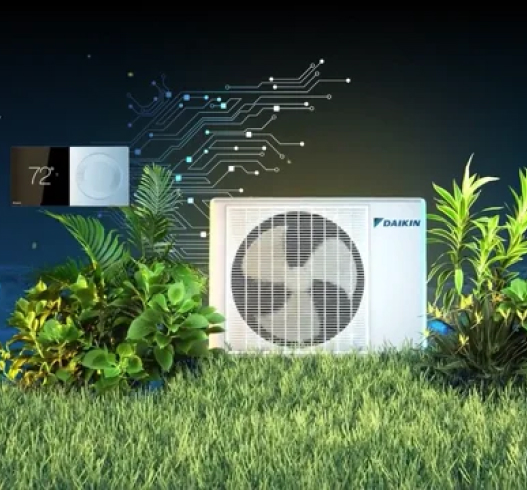Heat Pump vs. Air Conditioner: What is the Difference?
 Air conditioners and heat pumps use the same fundamental process—a closed-loop refrigeration cycle. These systems use the same fundamental process—a closed-loop refrigeration cycle. This means the refrigerant continuously circulates through the system, absorbing and releasing heat as it moves between the evaporator coil and other key components, ensuring consistent cooling and comfort.
Air conditioners and heat pumps use the same fundamental process—a closed-loop refrigeration cycle. These systems use the same fundamental process—a closed-loop refrigeration cycle. This means the refrigerant continuously circulates through the system, absorbing and releasing heat as it moves between the evaporator coil and other key components, ensuring consistent cooling and comfort.
How Do Air Conditioners and Heat Pumps Keep You Cool?1
- Warm Air Intake: A motorized fan pulls warm indoor air into the ductwork, extracting heat to cool your home.
- Cooling Process: The air passes over a cold evaporator coil filled with refrigerant. As the refrigerant absorbs heat, it transitions from a liquid to a gas, effectively cooling the air.
- Circulating Cool Air: The cooled air is distributed through ducts and vents, lowering the indoor temperature. Since drier air feels cooler, removing humidity enhances comfort.
- Heat Release Outdoors: The refrigerant, now a warm gas, moves through a closed-loop system to the outdoor coil (condenser). Here, it releases heat and condenses back into a liquid, much like moisture forming on a cold window.
- Refrigerant Circulation: A compressor pumps the refrigerant between the indoor and outdoor coils, regulating pressure and ensuring continuous heat transfer.
- Temperature Regulation: When the indoor temperature reaches the thermostat’s set point, the system slows down (for adaptive inverter systems) or stops until cooling is needed again.
- Ongoing Cooling Cycle: This refrigeration cycle repeats as needed, providing consistent cooling and comfort year-round.
The Difference is in the Valve!
While heat pumps and air conditioners operate on the same basic refrigeration principle, there’s one key difference—the ability to reverse direction. Much like a reversible jacket, the “magic” of a heat pump happens when the system switches modes.
Unlike an air conditioner, a heat pump is equipped with a reversing valve that changes the direction of refrigerant flow when heating is required instead of cooling. The refrigeration cycle operates on the principle that heat naturally moves toward cooler areas, and when a liquid expands into a gas, it absorbs heat from its surroundings.
In heating mode, the reversing valve redirects the refrigerant, causing the outdoor coil to become cold enough to absorb heat from the outside air—even in chilly temperatures. This is the opposite of cooling mode, where the indoor coil absorbs heat from inside your home to maintain a comfortable temperature.
How Does a Heat Pump Keep You Warm?
- Reversing the Cycle: The reversing valve shifts the direction of the refrigeration cycle, making the outdoor coil function as the evaporator and the indoor coil as the condenser.
- Absorbing Heat Outdoors: As refrigerant flows through the outdoor coil, it absorbs heat from the outside air and changes from a gas to a liquid.
- Extracting Heat Energy: Even in cold temperatures, the chilled outdoor coil can still capture enough heat energy to warm your home. The absorbed heat is transferred inside through the refrigerant cycle.
- Pulling in Indoor Air: A motorized fan in the air handler pulls cool indoor air into the ductwork.
- Transferring Heat: As the refrigerant releases its heat through the indoor coil, the cool indoor air absorbs the warmth.
- Circulating Warm Air: The compressor moves refrigerant between the coils, regulating pressure and maintaining heat transfer.
- Distributing Warmth: The now-warmed air is pushed through ducts and vents, raising the indoor temperature until it reaches the thermostat’s set point.
- Temperature Regulation: Once the desired temperature is reached, the heat pump pauses until heating is needed again.
- Reliable Comfort Year-Round: This cycle continues as needed, providing efficient and consistent warmth.
Traditionally, heat pumps were primarily used in regions with mild winters. However, advancements in air-source heat pump technology enable select systems to operate even in areas with prolonged subfreezing temperatures, and for some, such as the Daikin AURORA models, even in extreme cold.
In this article
Connect on Social Media
 Follow on Facebook
Follow on Facebook
 Follow on YouTube
Follow on YouTube
 Follow on Instagram
Follow on Instagram
 Follow on X
Follow on X
 Follow on TikTok
Follow on TikTok
 Follow on Pinterest
Follow on Pinterest

Looking for help now?
Enter your zip code to search for Daikin Contractors in your area.
Learn More
Learning Center Content
Stay informed about home comfort technology, when to upgrade, energy efficiency, and reducing your energy bills.





























